
Samuel Pepys was an English diarist and naval administrator. He served as administrator of the Royal Navy and Member of Parliament, but is most remembered today for the diary he kept for almost a decade. Though he had no maritime experience, Pepys rose to be the Chief Secretary to the Admiralty under both King Charles II and King James II through patronage, diligence, and his talent for administration. His influence and reforms at the Admiralty were important in the early professionalisation of the Royal Navy.

Charles II was King of Scotland from 1649 until 1651 and King of England, Scotland, and Ireland from the 1660 Restoration of the monarchy until his death in 1685.

Fotheringhay is a village and civil parish in North Northamptonshire, England. It is 4 miles (6.4 km) north-east of Oundle and around 13 miles (21 km) west of Peterborough. It is most noted for being the site of Fotheringhay Castle which was razed in 1627. There is nothing left of the castle to be seen today other than the motte on which it was built that provides excellent views of the River Nene. The Nene Way long distance footpath runs through the village.

Magdalene College is a constituent college of the University of Cambridge. The college was founded in 1428 as a Benedictine hostel, in time coming to be known as Buckingham College, before being refounded in 1542 as the College of St Mary Magdalene.
Teti, less commonly known as Othoes, sometimes also Tata, Atat, or Athath in outdated sources, was the first king of the Sixth Dynasty of Egypt. He was buried at Saqqara. The exact length of his reign has been destroyed on the Turin King List but is believed to have been about 12 years.

Barbara Palmer, 1st Duchess of Cleveland, Countess of Castlemaine, was an English royal mistress of the Villiers family and perhaps the most notorious of the many mistresses of King Charles II of England, by whom she had five children, all of them acknowledged and subsequently ennobled. Barbara was the subject of many portraits, in particular by court painter Sir Peter Lely.

Eleanor Gwyn was an English stage actress and celebrity figure of the Restoration period. Praised by Samuel Pepys for her comic performances as one of the first actresses on the English stage, she became best known for being a long-time mistress of King Charles II of England.

Pall Mall is a street in the St James's area of the City of Westminster, Central London. It connects St James's Street to Trafalgar Square and is a section of the regional A4 road. The street's name is derived from pall-mall, a ball game played there during the 17th century, which in turn is derived from the Italian pallamaglio, literally "ball-mallet".

The Church of St Margaret, Westminster Abbey is in the grounds of Westminster Abbey on Parliament Square, London, England. It is dedicated to Margaret of Antioch, and forms part of a single World Heritage Site with the Palace of Westminster and Westminster Abbey.
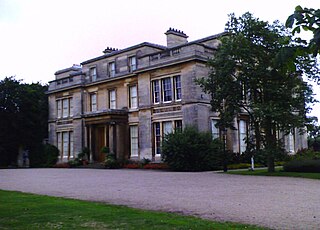
Normanby Hall is a classic English mansion, located near the village of Burton-upon-Stather, 5 miles (8 km) north of Scunthorpe, North Lincolnshire.

Charles Sackville, 6th Earl of Dorset and 1st Earl of Middlesex, KG was an English poet and courtier.
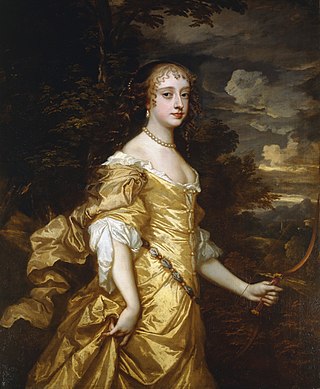
Frances Teresa Stewart, Duchess of Richmond and Lennox was a prominent member of the Court of the Restoration and famous for refusing to become a mistress of Charles II of England. For her great beauty she was known as La Belle Stuart and served as the model for an idealised, female Britannia. She is one of the Windsor Beauties painted by Sir Peter Lely.
Catisfield is an area of Fareham, Hampshire, England. Originally a small village in its own right, it has now merged with the western edge of the town.
Francis Talbot, 11th Earl of Shrewsbury, 11th Earl of Waterford, was an English peer who was a Royalist officer in the English Civil War. He survived the war only to be mortally wounded in a duel with the Duke of Buckingham who was having an affair with his wife.

Lisle's Tennis Court was a building off Portugal Street in Lincoln's Inn Fields in London. Originally built as a real tennis court, it was used as a playhouse during two periods, 1661–1674 and 1695–1705. During the early period, the theatre was called Lincoln's Inn Fields Playhouse, also known as The Duke's Playhouse, The New Theatre or The Opera. The building was rebuilt in 1714, and used again as a theatre for a third period, 1714–1732. The tennis court theatre was the first public playhouse in London to feature the moveable scenery that would become a standard feature of Restoration theatres.
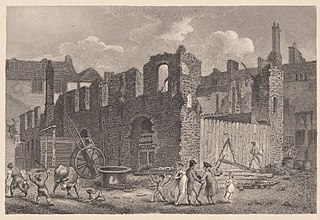
Gibbon's Tennis Court was a building off Vere Street and Clare Market, near Lincoln's Inn Fields in London, England. Originally built as a real tennis court, it was used as a playhouse from 1660 to 1663, shortly after the English Restoration. As a theatre, it has been variously called the "Theatre Royal, Vere Street", the "Vere Street Theatre", or simply "The Theatre". It was the first permanent home for Thomas Killigrew's King's Company and was the stage for some of the earliest appearances by professional actresses.
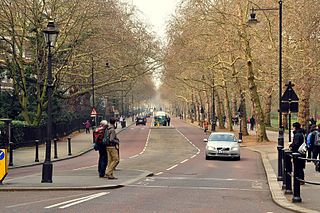
Birdcage Walk is a street in the City of Westminster in London. It runs east–west as a continuation of Great George Street, from the crossroads with Horse Guards Road and Storey's Gate, with the Treasury building and the Institution of Mechanical Engineers on the northeast corner, to a junction with Buckingham Gate, at the southeast corner of Buckingham Palace. St. James's Park lies to the north, whilst to the south are the backs of buildings on Old Queen Street, Queen Anne's Gate and Petty France, and, at the western end, the Wellington Barracks of the Brigade of Guards.

Clapham Common Northside is a road in South West London. One part of it is the A3 which leads to Portsmouth.

Grafton Manor was established before the Norman Conquest. Grafton means "settlement at or near the wood" and may indicate a role in woodland management within a larger estate, for instance.
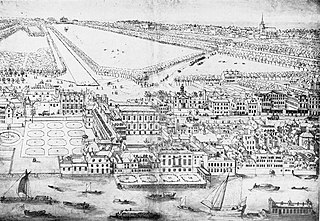
The Privy Garden of the Palace of Whitehall was a large enclosed space in Westminster, London, that was originally a pleasure garden used by the late Tudor and Stuart monarchs of England. It was created under Henry VIII and was expanded and improved under his successors, but lost its royal patronage after the Palace of Whitehall was almost totally destroyed by fire in 1698.


















